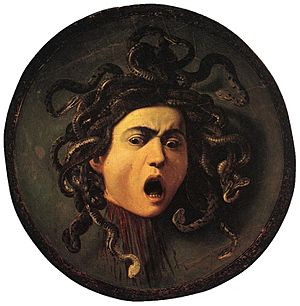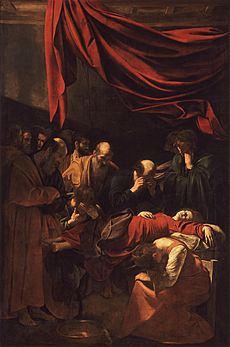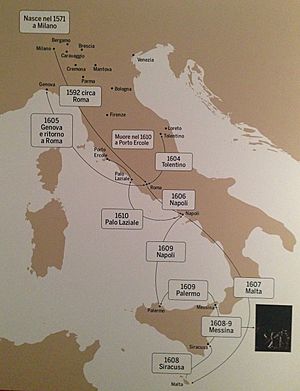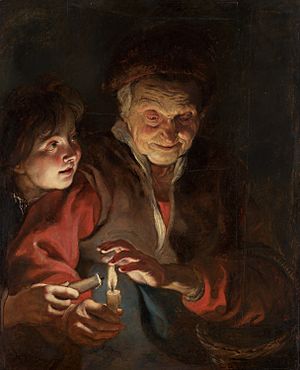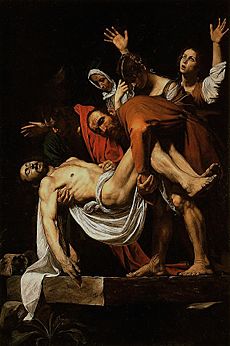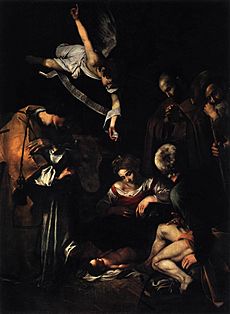Caravaggio facts for kids
Quick facts for kids
Caravaggio
|
|
|---|---|

A chalk portrait of Caravaggio by Ottavio Leoni, around 1621.
|
|
| Born |
Michelangelo Merisi or Amerighi da Caravaggio
29 September 1571 |
| Died | 18 July 1610 (aged 38) Porto Ercole, State of the Presidi, Kingdom of Naples, Spanish Empire
|
| Education | Simone Peterzano |
| Known for | Painting |
|
Notable work
|
See Chronology of works by Caravaggio |
| Movement | Baroque |
| Patron(s) | Cardinal Francesco Maria del Monte Alof de Wignacourt |
Michelangelo Merisi da Caravaggio, known simply as Caravaggio, was an Italian painter. He was born on September 29, 1571, and died on July 18, 1610. He spent most of his artistic life in Rome. In his last four years, he traveled between Naples, Malta, and Sicily before he passed away.
Caravaggio's paintings are famous for showing people in a very real way, both physically and emotionally. He also used light and shadow in a dramatic style called chiaroscuro, which later became known as tenebrism. This way of painting had a big impact on the Baroque art movement.
He used strong contrasts of light and dark to make his subjects stand out. Caravaggio often painted important moments, sometimes showing intense struggles or even death. He worked quickly, painting directly onto the canvas with live models, instead of making many drawings first. His unique style greatly influenced the new Baroque art, and artists who followed his methods were called "Caravaggisti".
Caravaggio trained as a painter in Milan. He moved to Rome in his twenties and became a well-known artist. However, he was also known for being a difficult and challenging person. After a serious fight, he had to leave Rome and went to Naples. There, he quickly became one of the most important Italian painters of his time. He then traveled to Malta and Sicily, hoping to receive a pardon for his past actions. In 1609, he returned to Naples, where he was involved in another fight that left his face injured. He died in 1610 under unclear circumstances while traveling back to Rome. Some reports say he died of a fever, while others suggest he might have been harmed or suffered from lead poisoning.
Caravaggio's new ideas inspired Baroque painting. However, over time, his style became less popular as art trends changed. In the 20th century, people rediscovered his work and realized how important he was to Western art. A historian named André Berne-Joffroy even said that modern painting truly began with Caravaggio.
The Story of Caravaggio
His Early Life (1571–1592)
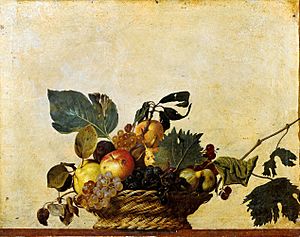
Caravaggio, whose real name was Michelangelo Merisi, was born in Milan. His father, Fermo, worked for the Marchese of Caravaggio, a town near Milan. In 1576, his family moved to Caravaggio to escape a terrible plague in Milan. Sadly, his father and grandfather both died there in 1577. It's believed that Caravaggio grew up in this town. His family had connections with powerful families like the Sforzas and the Colonna family, who would later play a big role in his life.
Caravaggio's mother raised her five children in poverty. She passed away in 1584. In the same year, Caravaggio began a four-year apprenticeship with the Milanese painter Simone Peterzano. Peterzano was said to be a student of the famous artist Titian. After his training, Caravaggio likely stayed in the Milan-Caravaggio area. He might have visited Venice and seen the works of Giorgione and Titian. He would also have known about the art treasures in Milan, like Leonardo da Vinci's Last Supper. He was familiar with the local Lombard art style, which focused on simplicity and realistic details, different from the more formal Roman Mannerism.
Starting Out in Rome (1592/95–1600)
After his training, Caravaggio left Milan for Rome around 1592 because of some disagreements and an incident involving a police officer. When he arrived in Rome, he was very poor and had no fixed home. For a while, he stayed with Pandolfo Pucci, who was known for being very stingy. A few months later, he worked for the successful artist Giuseppe Cesari, who was a favorite of Pope Clement VIII. In Cesari's workshop, Caravaggio mostly painted flowers and fruit.
Rome at that time had a great demand for paintings to fill its many new churches and palaces. The Church was also looking for a new art style for religious works to respond to the rise of Protestantism. Caravaggio's new approach was a very realistic style. He combined close observation of people and things with a dramatic use of light and shadow, known as tenebrism.
Some of his early works from this time include a small Boy Peeling a Fruit (his earliest known painting), a Boy with a Basket of Fruit, and the Young Sick Bacchus. The Young Sick Bacchus is thought to be a self-portrait he painted while recovering from a serious illness that ended his work with Cesari. These paintings show how Caravaggio paid close attention to physical details. For example, a professor of horticulture studied the fruit in Boy with a Basket of Fruit and could identify specific types of fruit, even noticing a fungal spot on a fig leaf!
Caravaggio left Cesari after a disagreement. He then made important friends, including the painter Prospero Orsi, the architect Onorio Longhi, and the young Sicilian artist Mario Minniti. Orsi helped him meet important art collectors. Longhi, unfortunately, introduced him to the world of street fights in Rome. Minniti often modeled for Caravaggio and later helped him get important painting jobs in Sicily.
The Fortune Teller was his first painting with more than one person. It shows a boy, probably Minniti, having his palm read by a Romani girl who is secretly taking his ring. This subject was new in Rome and became very popular. However, Caravaggio sold it for very little money. The Cardsharps, which shows another innocent young man being tricked by card cheats, is even more complex. Like The Fortune Teller, it was very popular, and many copies were made. More importantly, it caught the eye of Cardinal Francesco Maria del Monte, a leading art expert in Rome. For Del Monte and his wealthy friends, Caravaggio painted several private pieces like The Musicians, The Lute Player, a tipsy Bacchus, and a realistic Boy Bitten by a Lizard. These paintings featured Minniti and other young models.

Caravaggio's first religious paintings also showed his realistic style and a deep sense of spirituality. One of these was the Penitent Magdalene, showing Mary Magdalene. It looked like a normal girl drying her hair, not a dramatic religious scene. This was a quiet, Lombard style, different from the more theatrical Roman art of the time. He followed this with other similar works: Saint Catherine; Martha and Mary Magdalene; Judith Beheading Holofernes; a Sacrifice of Isaac; a Saint Francis of Assisi in Ecstasy; and a Rest on the Flight into Egypt. These paintings, seen by a smaller group of people, increased Caravaggio's fame among experts and other artists. But to become truly famous, he needed public commissions from the Church.
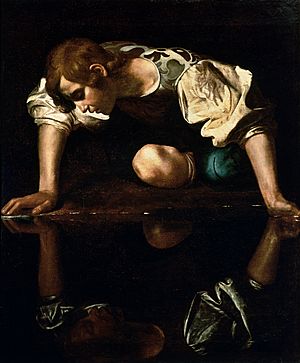
Caravaggio was already known for his intense realism. He liked to paint subjects exactly as he saw them, with all their natural imperfections, rather than making them look perfect. This allowed him to show off his amazing talent. This approach was very controversial at the time because it was different from the accepted style and the classical idealism of Michelangelo. Caravaggio also skipped the long preparations that were common in central Italy. Instead, he preferred the Venetian way of painting directly with oils from a live subject. Supper at Emmaus, from around 1600–1601, is a great example of his talent from this period.
Rome's Most Famous Painter (1600–1606)
In 1599, probably with help from Del Monte, Caravaggio was hired to decorate the Contarelli Chapel in the church of San Luigi dei Francesi. The two paintings for this job, The Martyrdom of Saint Matthew and The Calling of Saint Matthew, were delivered in 1600 and became an instant hit. After that, he always had plenty of work and supporters.
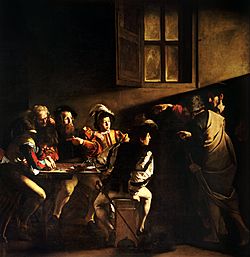
Caravaggio's tenebrism (strong light and shadow) brought great drama to his paintings. His realistic style added a new level of emotion. Other artists had mixed feelings about his work. Some criticized him for painting directly from life without drawings. But most praised him as a brilliant artist: "The painters then in Rome were greatly taken by this novelty, and the young ones particularly gathered around him, praised him as the unique imitator of nature, and looked on his work as miracles."
Caravaggio continued to get important jobs for religious paintings that often showed intense struggles, pain, and death. Among his most famous and skillful works are The Incredulity of Saint Thomas (around 1601) and The Taking of Christ (around 1602) for the Mattei family. These were only rediscovered in the 1990s after being lost for two centuries. Most of his new paintings increased his fame, but some were rejected by the churches or groups that ordered them. They had to be repainted or sold to new buyers. The main issue was that while people liked Caravaggio's dramatic style, some found his realism too ordinary or even rude.
His first version of Saint Matthew and the Angel showed the saint as a bald peasant with dirty legs, with a young angel who seemed too familiar. This was rejected, and he had to paint a second version, The Inspiration of Saint Matthew. Similarly, The Conversion of Saint Paul was rejected. Another version of the same subject, the Conversion on the Way to Damascus, was accepted. However, it showed the saint's horse much more clearly than Saint Paul himself. This led to a funny conversation between Caravaggio and a church official: "Why have you put a horse in the middle, and Saint Paul on the ground?" "Because!" "Is the horse God?" "No, but he stands in God's light!"
The Incredulity of Saint Thomas is one of Caravaggio's most famous paintings, from around 1601-1602. There are two versions painted by Caravaggio himself. One is for the church, and the other is a secular version. The painting shows the story of "Doubting Thomas" from the Gospel of John. Thomas the Apostle missed seeing Jesus after his resurrection and said he wouldn't believe unless he could touch Jesus's wounds. A week later, Jesus appeared and told Thomas to touch him.
Both paintings show the doubting apostle putting his finger into Christ's side wound, with Christ guiding his hand. The unbeliever looks like a peasant, with torn clothes and dirt under his fingernails. The way the painting is composed makes the viewer feel like they are right there, experiencing the intense moment.
Other works from this period include Entombment, the Madonna di Loreto (Madonna of the Pilgrims), the Grooms' Madonna, and the Death of the Virgin. The story of the last two paintings shows how some of Caravaggio's art was received. The Grooms' Madonna, painted for an altar in Saint Peter's Basilica in Rome, was only there for two days before it was removed. A cardinal's secretary wrote that it seemed to be "a work made by a painter that can paint well, but of a dark spirit, and who has been for a lot of time far from God..."
The Death of the Virgin, ordered in 1601 for a private chapel, was rejected by the Carmelites in 1606. However, this rejection didn't mean Caravaggio or his paintings were out of favor. As soon as Death of the Virgin was taken out of the church, the Duke of Mantua bought it, following advice from Rubens. Later, Charles I of England acquired it before it joined the French royal collection in 1671.
One non-religious painting from these years is Amor Vincit Omnia, also called Amor Victorious, painted in 1602. It was for Vincenzo Giustiniani, a friend of Del Monte. The model for this painting was named "Cecco", possibly Francesco Boneri, who later became an artist known as Cecco del Caravaggio. The painting shows Cupid, the Roman god of love, with a bow and arrows, stepping on symbols of arts and sciences. He is unclothed, and it's hard to see this smiling boy as the god Cupid, just as it was hard to see Caravaggio's other partly clothed young models as angels, even with stage wings. The painting's power comes from its intense and real feel: it is both Cupid and Cecco, just as Caravaggio's Virgins were both the Mother of Christ and the Roman girls who modeled for them.
Trouble and Flight from Rome (1606)
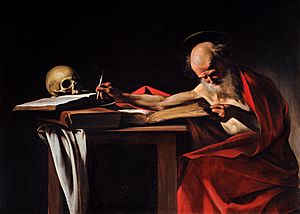
Caravaggio lived a very eventful life. He was known for getting into fights, even in a time when such behavior was common. His police records and court trials fill many pages.
Some accounts claim that around 1590–1592, Caravaggio committed a serious act that forced him to leave Milan, first for Venice and then for Rome.
On November 28, 1600, while living with his patron Cardinal Del Monte, Caravaggio hit a nobleman named Girolamo Stampa with a club. This led to an official complaint to the police. Fights and arguments became more and more frequent for Caravaggio. He was often arrested and put in jail.
After being released from jail in 1601, Caravaggio painted The Taking of Christ and then Amor Vincit Omnia. In 1603, he was arrested again. This time, it was for insulting another painter, Giovanni Baglione, who sued Caravaggio and his friends for writing offensive poems about him. The French ambassador stepped in, and Caravaggio was placed under house arrest after a month in jail.
Between May and October 1604, Caravaggio was arrested several times for having illegal weapons and for insulting city guards. He was also sued by a waiter for throwing a plate of artichokes in his face.
An early report from 1604 described his lifestyle from three years earlier: "after a fortnight's work he will swagger about for a month or two with a sword at his side and a servant following him, from one ball-court to the next, ever ready to engage in a fight or an argument, so that it is most awkward to get along with him."
In 1605, Caravaggio had to flee to Genoa for three weeks after seriously injuring a notary named Mariano Pasqualone in a dispute. Caravaggio's supporters helped to cover up the incident.
When he returned to Rome, Caravaggio was sued by his landlady for not paying rent. In anger, he threw rocks through her window at night and was sued again. In November, he was hospitalized for an injury he claimed he got from falling on his own sword.
On May 29, 1606, Caravaggio was involved in a fight that resulted in the death of a young man named Ranuccio Tommasoni. The circumstances are unclear, but it may have been an accident during a fight or a duel. Many rumors spread about the cause of the fight, including a disagreement over a gambling debt.
Caravaggio's supporters had always protected him from serious trouble before. But Tommasoni's wealthy family was very upset and demanded justice. Caravaggio's supporters could not protect him this time. Caravaggio was sentenced to death, and anyone who recognized him was allowed to carry out the sentence.
Caravaggio was forced to leave Rome. He moved south of the city, then to Naples, Malta, and Sicily.
Life in Exile and Death (1606–1610)
Naples
After the incident with Tomassoni, Caravaggio first fled to the estates of the Colonna family south of Rome. Then he went to Naples, where Costanza Colonna Sforza, whose husband's family Caravaggio's father had worked for, had a palace. In Naples, outside the reach of Roman authorities and protected by the Colonna family, Caravaggio became the most famous painter in the city.
His connections with the Colonnas led to many important church commissions, including the Madonna of the Rosary and The Seven Works of Mercy. The Seven Works of Mercy shows seven acts of kindness related to helping others in need. The painting was made for and is still in the church of Pio Monte della Misericordia in Naples. Caravaggio combined all seven acts of mercy into one painting, which became the church's altarpiece.
Malta
Even though he was successful in Naples, Caravaggio left for Malta, the home of the Knights of Malta, after only a few months. Fabrizio Sforza Colonna, Costanza's son, was a Knight of Malta. He likely helped Caravaggio arrive on the island in 1607 and escape the next year. Caravaggio probably hoped that the support of Alof de Wignacourt, the Grand Master of the Knights, could help him get a pardon for Tomassoni's death. Wignacourt was so impressed to have the famous artist as the official painter for the Order that he made him a Knight. Early biographers say Caravaggio was very happy with his success.
Major works from his time in Malta include The Beheading of Saint John the Baptist, his largest painting ever and the only one he signed. Also, Saint Jerome Writing (both in Saint John's Co-Cathedral, Valletta, Malta) and a Portrait of Alof de Wignacourt and his Page, as well as portraits of other leading Knights. The Beheading of Saint John the Baptist is considered one of the most important works in Western painting. Finished in 1608, it was ordered by the Knights of Malta as an altarpiece and was the largest altarpiece Caravaggio painted. It still hangs in St. John's Co-Cathedral, where Caravaggio himself became a knight.
However, by late August 1608, he was arrested and imprisoned, likely after another fight, this time with an aristocratic knight. Caravaggio was jailed by the Knights in Valletta, but he managed to escape. By December, he had been formally expelled from the Order.
Sicily
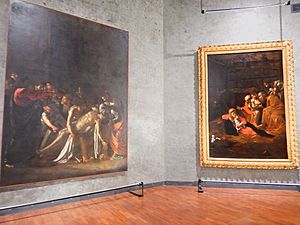
Caravaggio went to Sicily where he met his old friend Mario Minniti, who was now married and living in Syracuse. Together, they went on a successful tour from Syracuse to Messina and possibly to Palermo. In Syracuse and Messina, Caravaggio continued to get important and well-paying commissions. Works from this period include Burial of St. Lucy, The Raising of Lazarus, and Adoration of the Shepherds. His style kept changing, now showing figures standing alone against huge, empty backgrounds. These paintings suggest the fears and weaknesses of people, and also show a new, gentle beauty in humility. Reports from the time describe him acting more and more strangely, like sleeping fully armed and in his clothes, tearing up a painting if someone criticized it slightly, and making fun of local painters.
Caravaggio's strange behavior was noted early in his career. His actions seemed to become even more unusual after his time in Malta. Historians describe him being driven by "fear" from city to city across the island, eventually returning to Naples because he felt it was no longer safe to stay.
Return to Naples
After only nine months in Sicily, Caravaggio returned to Naples in late summer 1609. He was reportedly being pursued by enemies in Sicily and felt safest under the protection of the Colonnas until he could get a pardon from the pope (Paul V) and return to Rome. In Naples, he painted The Denial of Saint Peter, a final John the Baptist (Borghese), and his last picture, The Martyrdom of Saint Ursula. His style continued to change, becoming more free and expressive. Saint Ursula is shown in a moment of intense action, as an arrow hits her.
In October 1609, he was involved in a violent incident, possibly an attack on his life. His face was badly injured, and rumors spread in Rome that he was dead. He painted a Salome with the Head of John the Baptist (Madrid), showing his own head on a platter, and sent it to Wignacourt as a plea for forgiveness. Around this time, he might also have painted a David with the Head of Goliath. He may have sent this painting to his supporter, Cardinal Scipione Borghese, the pope's nephew, who had the power to grant pardons. Caravaggio hoped Borghese could help him get a pardon in exchange for his artworks.
Good news from Rome encouraged Caravaggio. In the summer of 1610, he took a boat north to receive the pardon, which seemed very close thanks to his powerful friends in Rome. With him were three last paintings, gifts for Cardinal Scipione. What happened next is still a mystery.
Reports from July 1610 stated that Caravaggio had died. One report said he died of a fever on his way from Naples to Rome. A poet friend later said he died on July 18. Recent research claims to have found a death notice showing he died on that day from a fever in Porto Ercole, a town in Tuscany.
His Death
Caravaggio had a fever when he died. The cause of his death was debated at the time and is still studied today. Some rumors said that the Tommasoni family or the Knights had him killed for revenge. Some historians suggest he died of malaria or brucellosis (from unpasteurized dairy). Other scholars believe he was attacked and killed by the same "enemies" who had been after him since he left Malta.
Caravaggio's remains were buried in a cemetery in Porto Ercole. In 2010, archaeologists investigated remains found in three crypts. Using DNA, carbon dating, and other methods, they believe with high confidence that they have identified Caravaggio's remains. Early tests suggested he might have died of lead poisoning, as paints at the time contained a lot of lead, and lead poisoning can cause violent behavior. Later research concluded he died from an infection caused by a wound he got in a fight in Naples.
Vatican documents released in 2002 support the idea that the wealthy Tommasoni family had him hunted down and killed as revenge for the death of Ranuccio Tommasoni.
Caravaggio as an Artist
The Start of Baroque Art

Caravaggio made shadows a very important part of his art. While artists used light and shadow (chiaroscuro) before him, Caravaggio made it a main feature. He made the shadows very dark and lit up his subjects with bright beams of light. This, along with his careful observation of physical and emotional reality, made him very popular but also caused problems with his religious paintings.
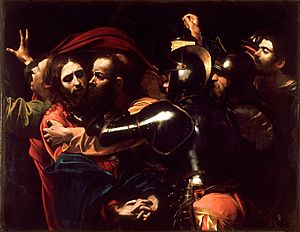
He painted very quickly, working directly from live models and marking basic guides on the canvas with his brush handle. Very few of Caravaggio's drawings have survived, suggesting he preferred to paint without them. This method was disliked by many skilled artists of his time, who criticized him for not using drawings and for not making his figures look ideal. However, his models were key to his realistic style. Some have been identified, like Mario Minniti and Francesco Boneri, both fellow artists. Minniti appears as various figures in his early works, and the young Boneri appears as angels, Baptists, and Davids in later paintings. His female models include Fillide Melandroni, Anna Bianchini, and Maddalena Antognetti, who appear as religious figures like the Virgin and saints. Caravaggio himself appears in several paintings, his last self-portrait being the witness on the far right of The Martyrdom of Saint Ursula.
Caravaggio had an amazing ability to show a crucial moment in a very vivid way. The Supper at Emmaus shows the moment Christ's disciples recognize him. One moment he is just a fellow traveler, and the next, he is the Savior. In The Calling of St Matthew, Saint Matthew points to himself as if saying, "who, me?", but his eyes, looking at Christ, have already said, "Yes, I will follow you." With The Resurrection of Lazarus, he goes even further, showing the actual physical process of resurrection. Lazarus's body is still stiff, but his hand, reaching towards Christ's, is alive. Other great Baroque artists, like Bernini, would follow this path.
The Caravaggisti
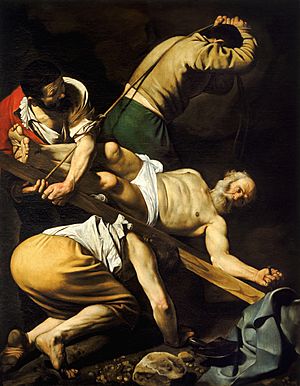
When Caravaggio's St. Matthew paintings were put in the Contarelli Chapel, they immediately influenced younger artists in Rome. Caravaggism became the exciting new style for ambitious young painters. The first artists influenced by him included Orazio Gentileschi and Giovanni Baglione. Baglione's Caravaggio phase was short; Caravaggio later accused him of copying his work, and they had a long rivalry. Baglione later wrote the first biography of Caravaggio. In the next generation of Caravaggisti were Carlo Saraceni, Bartolomeo Manfredi, and Orazio Borgianni. Gentileschi was the only one of these artists to live much longer than 1620 and became a court painter for Charles I of England. His daughter Artemisia Gentileschi was also very close to Caravaggio's style and one of the most talented artists of the movement. However, in Rome and Italy, it was the influence of his rival Annibale Carracci, who blended elements from the High Renaissance and Lombard realism, that eventually became more popular.
Caravaggio's short time in Naples led to a notable group of Neapolitan Caravaggisti, including Battistello Caracciolo and Carlo Sellitto. The Caravaggisti movement there ended with a terrible outbreak of plague in 1656. However, the connection with Spain (Naples was under Spanish rule) helped spread his influence to Spain.
Rubens was likely one of the first Flemish artists influenced by Caravaggio, whose work he saw during his stay in Rome in 1601. He later painted a copy of Caravaggio's Entombment of Christ and advised his patron, the Duke of Mantua, to buy The Death of the Virgin. While some of this interest in Caravaggio is seen in Rubens' drawings from his time in Italy, it was only after he returned to Antwerp in 1608 that Rubens' works clearly showed Caravaggio's traits, such as in Cain slaying Abel (1608–1609) and the Old Woman and Boy with Candles (1618–1619). However, Caravaggio's influence on Rubens was less important than that of Raphael, Correggio, Barocci, and the Venetians. Flemish artists influenced by Rubens, like Jacob Jordaens, Pieter van Mol, Gaspar de Crayer, and Willem Jacob Herreyns, also used some of the stark realism and strong light contrasts common in Caravaggio's style.
Several Catholic artists from Utrecht, including Hendrick ter Brugghen, Gerrit van Honthorst, and Dirck van Baburen, traveled to Rome in the early 17th century. There, they were greatly influenced by Caravaggio's work and his followers. When they returned to Utrecht, their Caravaggesque works inspired a short but important period of art, known as Utrecht Caravaggism. In the next generation of Dutch artists, Caravaggio's influence, though less direct, can be seen in the work of Vermeer and Rembrandt, even though neither of them visited Italy.
His Reputation: Lost and Found
Caravaggio's new ideas inspired the Baroque art movement. However, Baroque art often took the drama of his light and shadow without his deep psychological realism. While he directly influenced the artists mentioned above, and, from a distance, the French painters Georges de La Tour and Simon Vouet, and the Spanish painter Giuseppe Ribera, within a few decades his works were sometimes wrongly credited to other artists or simply forgotten. The Baroque style, to which he contributed so much, changed, and art trends shifted. Also, Caravaggio never set up a workshop like other artists, so he didn't have a school to spread his techniques. He also never wrote down his ideas about art, so his psychological realism can only be understood from his surviving works.
Because of this, his reputation was easily harmed by the negative comments of his earliest biographers. These included Giovanni Baglione, a rival painter who had a grudge against him, and the influential 17th-century critic Gian Pietro Bellori. Bellori, who didn't know Caravaggio personally, preferred the "classical-idealistic" style of the Bolognese school led by the Carracci family. Baglione, his first biographer, played a big part in creating the legend of Caravaggio's wild and violent personality, and also claimed he couldn't draw well.
In the 1920s, art critic Roberto Longhi brought Caravaggio's name back into the spotlight. He showed how important Caravaggio was to European art: "Ribera, Vermeer, La Tour and Rembrandt could never have existed without him. And the art of Delacroix, Courbet and Manet would have been utterly different." The influential Bernard Berenson agreed, saying: "With the exception of Michelangelo, no other Italian painter exercised so great an influence."
His Epitaph
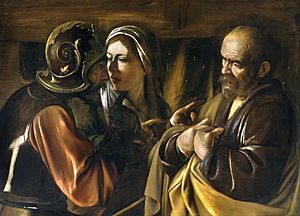
Caravaggio's epitaph (a short text honoring a deceased person) was written by his friend Marzio Milesi.
He was featured on the front of the Banca d'Italia 100,000-lire banknote in the 1980s and '90s (before Italy started using the euro). The back of the banknote showed his Basket of Fruit.
Art Theft
In October 1969, two thieves broke into the Oratory of Saint Lawrence in Palermo, Sicily, and stole Caravaggio's Nativity with St. Francis and St. Lawrence from its frame. Experts estimated its value at $20 million.
After the theft, Italian police created a special art theft team to find lost and stolen artworks. Since then, many clues have been followed regarding the Nativity. Former members of the Italian mafia have said that the Nativity with St. Francis and St. Lawrence was stolen by the Sicilian Mafia and displayed at important mafia meetings. Some former mafia members have said that the Nativity was damaged and has since been destroyed.
The painting's location is still unknown. A copy now hangs in its place in the Oratory of San Lorenzo.
Legacy
British filmmaker Derek Jarman made a well-received movie about Caravaggio called Caravaggio in 1986. Several poems by Thom Gunn were inspired by specific Caravaggio paintings.
In 2013, a traveling Caravaggio exhibition called "Burst of Light: Caravaggio and His Legacy" opened at the Wadsworth Atheneum Museum of Art in Hartford, Connecticut. The show included five paintings by the master artist, such as Saint John the Baptist in the Wilderness (1604–1605) and Martha and Mary Magdalene (1589). The exhibition also traveled to France and Los Angeles, California. Other Baroque artists like Georges de La Tour, Orazio Gentileschi, and the Spanish trio of Diego Velazquez, Francisco de Zurbaran, and Carlo Saraceni were also included in the exhibitions.
In 2022, a new movie about Caravaggio was released, called L'Ombra di Caravaggio, an Italian-French film directed by Michele Placido.
Images for kids
See also
 In Spanish: Caravaggio para niños
In Spanish: Caravaggio para niños
- Caravaggisti
- List of paintings by Caravaggio




